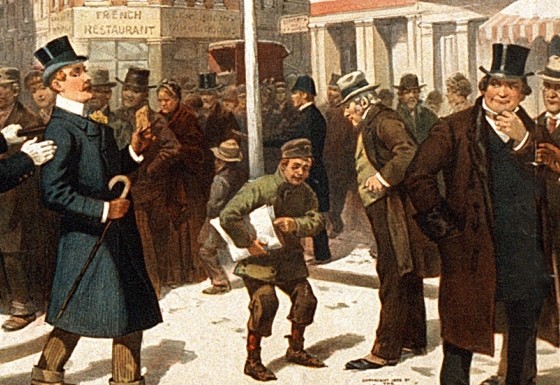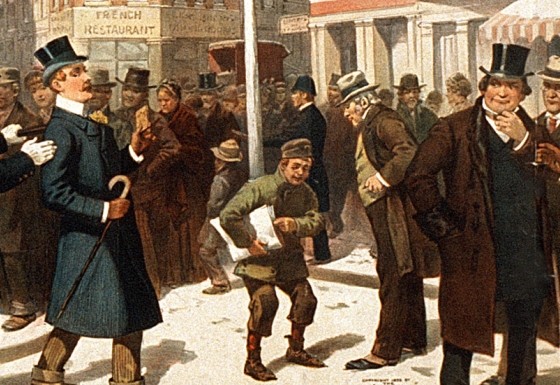
Early American Newspapers: Series 15, 1822-1879
Immigrant Communities
- Rare newspapers from more than 50 U.S. cities and towns
- Publications by and for former citizens of Germany, France, Ireland, Italy, Sweden, Netherlands, Norway, Scotland and more
- Important and influential 19th-century ethnic newspapers from the peak era of immigrant journalism
In 1830, America had approximately 200,000 foreign-born citizens; in 1880 there would be more than six million. Newspapers published by and for these newly arrived immigrants began in America’s Eastern seaboard cities, but by the 1840s they had spread into the heartland. In some communities new immigrants were welcomed, but in others they fell victim—often violently—to ethnic or religious prejudice.
Evidence of both reactions are nowhere better found than in the local or regional general-interest newspapers that competed with the immigrant papers. Early American Newspapers, Series 15, 1822-1879: Immigrant Communities, is designed to provide a one-of-a-kind window into both sides of this uniquely American story.
Broad coverage of the immigrant experience
Early American Newspapers, Series 15 contains 160 immigrant and general-interest newspapers, the latter included for valuable context. The immigrant newspapers are the primary component and consist of more than 100 of the most noteworthy immigrant/ethnic newspapers that were published in dozens of American cities and towns that had large immigrant populations during the 19th century. Complementing these are traditional, general-interest newspapers published contemporaneously in those same cities or regions. This combination of newspapers provides researchers with a unique, on-the-scene history of America’s immigrant communities during the peak era of ethnic journalism in the United States.
Many of the immigrant papers in Series 15 are considered the most important 19th-century publications of this genre. Others became successful and politically influential, and some are so rare that only a few copies are known to exist. Publications by and for former citizens of Germany, France, Ireland, Italy, Sweden, Netherlands, Denmark, Norway and Scotland are the most prevalent. Although a number were published in the native languages of the immigrant groups, many are bilingual.
To provide local historical context for the immigrant papers, more than 45 general-interest papers published during the same time period and in the same communities or regions are included.
A plethora of teaching and research applications
Early American Newspapers, Series 15, will be essential for researchers interested in Immigration History, Immigration Law, Ethnic Studies, Economic History, Labor History, Frontier History, Political Science, and Sociology.
Superior bibliographic control
Like other Early American Newspapers series, Series 15 offers many significant titles listed in the authoritative bibliographies by Clarence S. Brigham and Winifred Gregory. A distinguished academic advisory board guided the selection process, and all of the newspapers were sourced at the American Antiquarian Society.
The Early American Newspapers series is available within America’s Historical Newspapers.
Unprecedented coverage from every state west of the Mississippi River
Daily life in the metropolis
Courrier des Etats-Unis (New York, NY; 1828-1848 and 1862-1876)
- The Courrier was a published by French emigrants in New York City. It was founded in 1828 by Félix Lacoste with the help of Joseph Bonaparte (Napoleon's brother), who was living in New Jersey. The Courrier was the most famous French newspaper across North America, South America and the Caribbean. By 1850 it had more than 11,000 registered readers and was distributed from Quebec to Río de la Plata (Argentina), and from New York to San Francisco. It also had many readers in France.
Frank Leslie's Illustrirte Zeitung (New York, NY; 1860-1876)
- Frank Leslie’s Illustrated Newspapers were groundbreaking in that they contained large, detailed and accurate illustrations—a technological rarity at the time. They were so successful that Leslie expanded into thematic editions, one of which was the German-language Illustrirte Zeitung, which paid special attention to news related to German immigrants. During the Civil War thousands of readers nationwide turned to Leslie’s papers for their detailed, unblinking illustrations of the conflict. A Leslie's freelancer, James R. O'Neill, is believed to have been the only Civil War correspondent to have been killed in action.
Gamla Och Nya Hemlandet [Variously titled Gamla och nya hemlandet (the Old and New Homeland) and Hemlandet det gamla och det nya (the Homeland the Old and the New)] (Chicago, IL; 1864-1876)
- This was the first successful Swedish language newspaper published in the United States. It was founded by Augustana Lutheran minister Tuve Hasselquist, who acted as publisher and editor, and was intended to serve as the church's voice to the Swedish Lutheran community in the U.S. During the era covered here, Hemlandet was one of the most widely read Swedish language papers in the nation.
Irish World (New York, NY; 1872-1877)
- From its office in lower Manhattan, the weekly Irish World covered in detail the activities of Irish immigrants in New York and New England. A fervent advocate of Irish culture, literature and nationalism, the Irish World quickly became one of the most influential voices of the Irish community, which was the second largest immigrant group (after the German community) in America during the era covered here.
The Israelite (Cincinnati, OH; 1860-1873)
- The first Jewish newspaper published in Cincinnati was the English-language Israelite, established on July 15, 1854. It was also among the first Jewish publications in the nation. It was founded by Rabbi Isaac Mayer Wise, who became known as the father of Reform Judaism in the United States. Both Wise and the paper had a reach beyond Cincinnati, especially to the growing Jewish communities in the American Midwest and South.
Philadelphia Demokrat (Philadelphia, PA; 1838-1876)
- The Demokrat was founded in 1838 by a number of German-speaking Democrats for the purpose of supporting David R. Porter as a candidate for governor of Pennsylvania. It was one of the earliest and most important German newspapers in America. During its later years it was published by Edward Morwitz, whose newspaper, journal and book publishing company was the largest and most extensive German establishment of its kind in the United States.
Scottish American Journal (New York, NY; 1861-1879)
- Founded in New York City by publisher A.M. Stewart, the weekly Scottish American Journal was one of the most influential Scottish newspapers in America during the era covered here. It served as the voice of Scottish immigrants in New York, covering both Scottish-American relations in America as well as essays and literary works from Scotland.
Skandinaven (Chicago, IL; 1870-1876)
- Founded in Chicago by three Norwegian immigrants, John Anderson, Knud Langeland and Iver Lawson, the Skandinaven grew into one of the most influential and successful newspapers in the Scandinavian immigrant community. Through the success of the paper, Anderson was able to build a publishing business that became the largest Norwegian-American venture of its kind.
Tägliches Cincinnati Volksblatt (Cincinnati, OH; 1837-1876)
- In the early 19th century Cincinnati was home to a vast population of German-speaking immigrants. Established in 1836, the Tagliches Cincinnati Volksblatt became one of the most popular German-American newspapers in the Midwest and was the only daily German-language newspaper there for almost a decade. Serving as the mouthpiece for the German community, it informed its readers on local and national news, as well as offering a healthy dose of European news, as many people still had family overseas, keeping them apprised of happenings in their homeland.
Tagliche Illinois Staats-Zeitung (Chicago, IL; 1860-1876)
- Founded in Chicago in 1848, the Staats-Zeitung soon became the major daily of the Chicago German-born community. It played a major role in building the Republican Party in Illinois, and it was also an important organ of the “Forty-Eighters”—Europeans who supported the revolutions of 1848 that swept Europe. In the German states, the Forty-Eighters favored unification of the German people, a more democratic government and guarantees of human rights. By 1860, the Illinois Staats-Zeitung was the second-largest daily newspaper in Chicago.
Die Freie Presse (Philadelphia, PA; 1848-1876) and the Philadelphier Sonntags-Blatt (Philadelphia, PA; 1860-1866)
- Founded by F.W. Thomas in 1848, Die Freie Presse became one of Philadelphia’s most important and successful immigrant newspapers. The paper’s Sunday Edition—the Philadelphier Sonntags-Blatt (projected for years 1860-66), which is important for its Civil War coverage. During this era, Sunday editions were extra-large, and contained literary excerpts, reviews and cultural articles in addition to general interest news.
Deutsche Zeitung (Charleston, SC; 1872-1876)
- In South Carolina the most prominent contingent of German-speakers was in Charleston, where a vibrant artisan and mercantile community had been established before the Revolutionary War. By the 1850s, there was a German store on almost every street, and the bilingual, English and German language paper Deutsche Zeitung was founded in 1853. This run covers the city during the 1870s and offers researchers a fascinating look at how this immigrant community reacted to the tumultuous events of the Reconstruction era.
Stay in Touch
Receive product news, special offers and invitations, or the acclaimed Readex Report
Sign UpBy clicking "Sign Up", you acknowledge that you have read and understand our Privacy Policy and Terms of Use.





